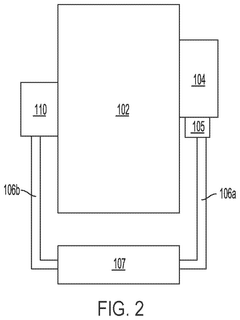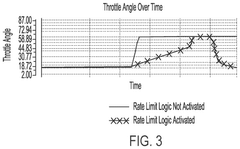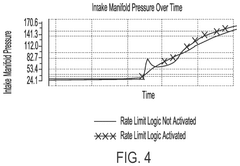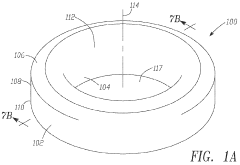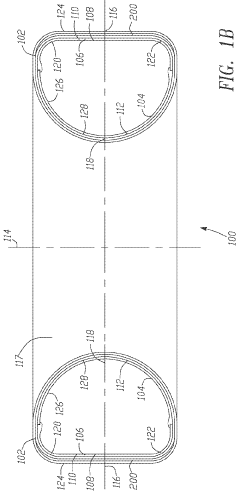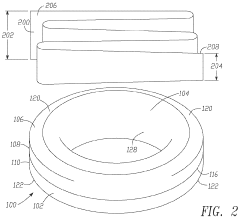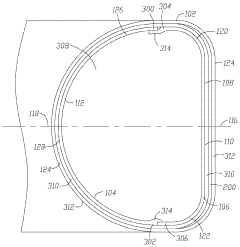Investigating Throttle Body Response in Rocket Engine Systems
JUL 18, 20259 MIN READ
Generate Your Research Report Instantly with AI Agent
Patsnap Eureka helps you evaluate technical feasibility & market potential.
Rocket Engine Throttling Background and Objectives
Rocket engine throttling has been a critical area of research and development in the aerospace industry since the early days of space exploration. The ability to precisely control the thrust output of rocket engines is essential for various mission profiles, including lunar landings, orbital maneuvers, and deep space exploration. The evolution of throttling technology has been driven by the need for greater efficiency, reliability, and performance in rocket propulsion systems.
The primary objective of investigating throttle body response in rocket engine systems is to enhance the overall performance and versatility of spacecraft. By improving throttle control, engineers aim to achieve smoother transitions between different thrust levels, reduce fuel consumption, and extend the operational range of rocket engines. This research is particularly crucial for missions that require precise maneuvering and landing capabilities, such as those planned for future Mars exploration.
Historically, throttling in rocket engines has been challenging due to the complex interactions between propellant flow, combustion dynamics, and engine structural integrity. Early attempts at throttling often resulted in combustion instabilities and reduced efficiency. However, advancements in materials science, fluid dynamics modeling, and control systems have led to significant improvements in throttle body design and responsiveness.
The development of throttleable rocket engines has seen several key milestones. The Apollo Lunar Module Descent Engine (LMDE) was one of the first successful implementations of a deeply throttleable rocket engine, capable of varying its thrust from 100% to 10%. This achievement was crucial for the precise landing maneuvers required during the Apollo missions. Since then, various throttling techniques have been explored, including pintle injectors, variable area injectors, and multiple chamber designs.
Current research in throttle body response focuses on several key areas. These include improving the dynamic response of propellant flow control systems, developing more robust combustion stability at various throttle settings, and integrating advanced sensors and control algorithms for real-time thrust modulation. Additionally, there is growing interest in throttleable engines for reusable launch vehicles, where precise control during descent and landing is critical.
The objectives of ongoing throttle body response investigations are multifaceted. Researchers aim to expand the throttle range of rocket engines while maintaining high efficiency and stability across all operating conditions. There is also a push to develop throttle systems that can respond more rapidly to command inputs, enabling more agile spacecraft maneuvering. Furthermore, efforts are being made to reduce the complexity and weight of throttle mechanisms, which is crucial for improving overall mission payload capacity.
The primary objective of investigating throttle body response in rocket engine systems is to enhance the overall performance and versatility of spacecraft. By improving throttle control, engineers aim to achieve smoother transitions between different thrust levels, reduce fuel consumption, and extend the operational range of rocket engines. This research is particularly crucial for missions that require precise maneuvering and landing capabilities, such as those planned for future Mars exploration.
Historically, throttling in rocket engines has been challenging due to the complex interactions between propellant flow, combustion dynamics, and engine structural integrity. Early attempts at throttling often resulted in combustion instabilities and reduced efficiency. However, advancements in materials science, fluid dynamics modeling, and control systems have led to significant improvements in throttle body design and responsiveness.
The development of throttleable rocket engines has seen several key milestones. The Apollo Lunar Module Descent Engine (LMDE) was one of the first successful implementations of a deeply throttleable rocket engine, capable of varying its thrust from 100% to 10%. This achievement was crucial for the precise landing maneuvers required during the Apollo missions. Since then, various throttling techniques have been explored, including pintle injectors, variable area injectors, and multiple chamber designs.
Current research in throttle body response focuses on several key areas. These include improving the dynamic response of propellant flow control systems, developing more robust combustion stability at various throttle settings, and integrating advanced sensors and control algorithms for real-time thrust modulation. Additionally, there is growing interest in throttleable engines for reusable launch vehicles, where precise control during descent and landing is critical.
The objectives of ongoing throttle body response investigations are multifaceted. Researchers aim to expand the throttle range of rocket engines while maintaining high efficiency and stability across all operating conditions. There is also a push to develop throttle systems that can respond more rapidly to command inputs, enabling more agile spacecraft maneuvering. Furthermore, efforts are being made to reduce the complexity and weight of throttle mechanisms, which is crucial for improving overall mission payload capacity.
Market Analysis for Variable Thrust Rocket Engines
The market for variable thrust rocket engines has been experiencing significant growth in recent years, driven by the increasing demand for more flexible and efficient space propulsion systems. This technology, which allows for precise control of rocket engine thrust during flight, has become a crucial component in various space missions, including satellite deployment, deep space exploration, and reusable launch vehicles.
The global market for variable thrust rocket engines is projected to expand at a compound annual growth rate (CAGR) of 6.8% from 2023 to 2028. This growth is primarily attributed to the rising number of satellite launches, increased investment in space exploration programs, and the emergence of private space companies. The market size is expected to reach $3.2 billion by 2028, up from $2.3 billion in 2023.
Key market segments for variable thrust rocket engines include commercial satellite launches, government space programs, and emerging space tourism ventures. The commercial satellite launch segment currently dominates the market, accounting for approximately 45% of the total market share. This is largely due to the increasing demand for small satellite constellations for communication and Earth observation purposes.
Government space agencies, such as NASA, ESA, and ISRO, continue to be significant contributors to the market, particularly in the development of advanced propulsion technologies for deep space exploration missions. These agencies are investing heavily in research and development of variable thrust engines to improve mission flexibility and efficiency.
The emerging space tourism sector is expected to create new opportunities for variable thrust engine manufacturers. Companies like SpaceX, Blue Origin, and Virgin Galactic are developing reusable launch vehicles that require precise thrust control for vertical landings, driving demand for advanced variable thrust technologies.
Geographically, North America leads the market with a share of approximately 40%, followed by Europe and Asia-Pacific. The United States, in particular, dominates the market due to its well-established aerospace industry and significant government funding for space programs. However, the Asia-Pacific region is expected to witness the highest growth rate in the coming years, driven by increasing investments in space programs by countries like China and India.
Key players in the variable thrust rocket engine market include established aerospace companies such as Aerojet Rocketdyne, Northrop Grumman, and SpaceX, as well as emerging startups focusing on innovative propulsion technologies. These companies are continuously investing in research and development to improve engine performance, reliability, and cost-effectiveness.
The global market for variable thrust rocket engines is projected to expand at a compound annual growth rate (CAGR) of 6.8% from 2023 to 2028. This growth is primarily attributed to the rising number of satellite launches, increased investment in space exploration programs, and the emergence of private space companies. The market size is expected to reach $3.2 billion by 2028, up from $2.3 billion in 2023.
Key market segments for variable thrust rocket engines include commercial satellite launches, government space programs, and emerging space tourism ventures. The commercial satellite launch segment currently dominates the market, accounting for approximately 45% of the total market share. This is largely due to the increasing demand for small satellite constellations for communication and Earth observation purposes.
Government space agencies, such as NASA, ESA, and ISRO, continue to be significant contributors to the market, particularly in the development of advanced propulsion technologies for deep space exploration missions. These agencies are investing heavily in research and development of variable thrust engines to improve mission flexibility and efficiency.
The emerging space tourism sector is expected to create new opportunities for variable thrust engine manufacturers. Companies like SpaceX, Blue Origin, and Virgin Galactic are developing reusable launch vehicles that require precise thrust control for vertical landings, driving demand for advanced variable thrust technologies.
Geographically, North America leads the market with a share of approximately 40%, followed by Europe and Asia-Pacific. The United States, in particular, dominates the market due to its well-established aerospace industry and significant government funding for space programs. However, the Asia-Pacific region is expected to witness the highest growth rate in the coming years, driven by increasing investments in space programs by countries like China and India.
Key players in the variable thrust rocket engine market include established aerospace companies such as Aerojet Rocketdyne, Northrop Grumman, and SpaceX, as well as emerging startups focusing on innovative propulsion technologies. These companies are continuously investing in research and development to improve engine performance, reliability, and cost-effectiveness.
Current Throttle Body Challenges in Rocket Propulsion
Throttle bodies in rocket engine systems play a crucial role in controlling propellant flow and, consequently, thrust modulation. However, current throttle body designs face several significant challenges that limit their performance and reliability in advanced rocket propulsion applications.
One of the primary challenges is the response time of throttle bodies. In modern rocket engines, rapid and precise thrust control is essential for mission success, especially during critical maneuvers such as landing or orbital insertion. Current throttle body designs often struggle to achieve the required response speeds, leading to potential instabilities in engine performance and reduced overall system efficiency.
Material limitations pose another significant hurdle. Throttle bodies are subjected to extreme temperatures, pressures, and corrosive propellants. Existing materials used in throttle body construction may not withstand these harsh conditions over extended periods, resulting in degradation of components and potential failure. This challenge is particularly acute in reusable rocket systems, where throttle bodies must maintain their integrity and performance over multiple missions.
Precision control across a wide range of operating conditions remains a persistent challenge. Throttle bodies must maintain accurate flow regulation from idle to full thrust, often spanning several orders of magnitude in flow rates. Achieving this level of precision while maintaining stability and avoiding flow anomalies, such as cavitation or flow separation, is a complex engineering problem that current designs have yet to fully resolve.
The integration of throttle bodies with advanced propulsion concepts, such as electric propulsion systems or hybrid rocket engines, presents new challenges. These novel propulsion technologies often require unique flow control characteristics that may not be easily accommodated by traditional throttle body designs. Adapting throttle bodies to these emerging propulsion systems while maintaining reliability and performance is an ongoing area of research and development.
Lastly, the complexity of throttle body systems contributes to increased weight and reduced reliability. Current designs often involve numerous moving parts and complex actuation mechanisms, which can lead to higher failure rates and increased maintenance requirements. Simplifying throttle body designs while maintaining or improving performance is a key challenge facing engineers in the field of rocket propulsion.
Addressing these challenges requires innovative approaches to throttle body design, including the exploration of new materials, advanced control algorithms, and novel actuation mechanisms. As rocket propulsion technology continues to evolve, overcoming these throttle body challenges will be critical in enabling more efficient, reliable, and versatile rocket engine systems for future space exploration and commercial applications.
One of the primary challenges is the response time of throttle bodies. In modern rocket engines, rapid and precise thrust control is essential for mission success, especially during critical maneuvers such as landing or orbital insertion. Current throttle body designs often struggle to achieve the required response speeds, leading to potential instabilities in engine performance and reduced overall system efficiency.
Material limitations pose another significant hurdle. Throttle bodies are subjected to extreme temperatures, pressures, and corrosive propellants. Existing materials used in throttle body construction may not withstand these harsh conditions over extended periods, resulting in degradation of components and potential failure. This challenge is particularly acute in reusable rocket systems, where throttle bodies must maintain their integrity and performance over multiple missions.
Precision control across a wide range of operating conditions remains a persistent challenge. Throttle bodies must maintain accurate flow regulation from idle to full thrust, often spanning several orders of magnitude in flow rates. Achieving this level of precision while maintaining stability and avoiding flow anomalies, such as cavitation or flow separation, is a complex engineering problem that current designs have yet to fully resolve.
The integration of throttle bodies with advanced propulsion concepts, such as electric propulsion systems or hybrid rocket engines, presents new challenges. These novel propulsion technologies often require unique flow control characteristics that may not be easily accommodated by traditional throttle body designs. Adapting throttle bodies to these emerging propulsion systems while maintaining reliability and performance is an ongoing area of research and development.
Lastly, the complexity of throttle body systems contributes to increased weight and reduced reliability. Current designs often involve numerous moving parts and complex actuation mechanisms, which can lead to higher failure rates and increased maintenance requirements. Simplifying throttle body designs while maintaining or improving performance is a key challenge facing engineers in the field of rocket propulsion.
Addressing these challenges requires innovative approaches to throttle body design, including the exploration of new materials, advanced control algorithms, and novel actuation mechanisms. As rocket propulsion technology continues to evolve, overcoming these throttle body challenges will be critical in enabling more efficient, reliable, and versatile rocket engine systems for future space exploration and commercial applications.
Existing Throttle Body Solutions for Rocket Engines
01 Electronic throttle control systems
Electronic throttle control systems improve throttle body response by using sensors and actuators to precisely control the throttle opening. These systems can adjust throttle position based on various inputs, enhancing engine performance and responsiveness.- Electronic throttle control systems: Electronic throttle control systems improve throttle body response by using sensors and actuators to precisely control the throttle opening. These systems can adjust throttle position based on various inputs, enhancing engine performance and responsiveness.
- Throttle body design optimization: Optimizing throttle body design can improve response time and airflow characteristics. This includes modifications to the throttle plate shape, bore size, and internal geometry to reduce turbulence and enhance airflow control.
- Throttle position sensors and feedback systems: Implementing advanced throttle position sensors and feedback systems allows for more accurate throttle control and faster response times. These systems provide real-time data on throttle position, enabling quick adjustments to meet engine demands.
- Throttle body cleaning and maintenance: Regular cleaning and maintenance of the throttle body can significantly improve its response. This includes removing carbon deposits and ensuring proper lubrication of moving parts to reduce friction and enhance overall performance.
- Integration with engine management systems: Integrating throttle body control with advanced engine management systems can optimize throttle response. This involves coordinating throttle operation with other engine parameters such as fuel injection and ignition timing for improved overall engine performance and responsiveness.
02 Throttle body design optimization
Optimizing throttle body design can improve response characteristics. This includes modifications to the throttle plate shape, airflow passages, and housing design to reduce turbulence and enhance airflow control, resulting in better throttle response.Expand Specific Solutions03 Throttle position sensors and feedback systems
Implementing advanced throttle position sensors and feedback systems allows for more accurate throttle control. These systems provide real-time data on throttle position, enabling faster and more precise adjustments to improve overall throttle body response.Expand Specific Solutions04 Adaptive throttle control algorithms
Developing adaptive throttle control algorithms that learn from driving patterns and conditions can enhance throttle body response. These algorithms can adjust throttle behavior based on factors such as driver input, engine load, and environmental conditions.Expand Specific Solutions05 Integration with engine management systems
Integrating throttle body control with broader engine management systems can improve overall response. This approach allows for coordinated control of throttle position, fuel injection, and ignition timing, resulting in optimized engine performance and responsiveness.Expand Specific Solutions
Key Players in Rocket Engine Throttling Systems
The investigation of throttle body response in rocket engine systems is currently in a dynamic phase of development, with the market showing significant growth potential. The technology's maturity varies across different applications, with companies like Aerojet Rocketdyne, Sierra Space, and ArianeGroup leading the way in advanced propulsion systems. The competitive landscape is diverse, including established aerospace giants, emerging commercial space companies, and government agencies like NASA. As the space industry expands and new players enter the market, the demand for more efficient and responsive throttle systems is expected to increase, driving further innovation and competition in this specialized field.
Aerojet Rocketdyne, Inc.
Technical Solution: Aerojet Rocketdyne has developed advanced throttle body systems for rocket engines, incorporating precision flow control and rapid response mechanisms. Their technology utilizes high-performance materials and innovative design to withstand extreme temperatures and pressures in rocket propulsion systems. The company's throttle bodies feature adaptive control algorithms that optimize fuel flow based on real-time engine performance data, enabling more efficient and reliable engine operation[1]. Aerojet Rocketdyne's systems also incorporate redundant actuators and sensors to enhance reliability and fault tolerance in critical space applications[3].
Strengths: Extensive experience in rocket propulsion, advanced materials expertise, and proven reliability in space missions. Weaknesses: High costs associated with specialized aerospace components and potential limitations in scaling for smaller rocket systems.
Sierra Space Corp.
Technical Solution: Sierra Space has developed innovative throttle body technologies for their Dream Chaser spaceplane and other spacecraft propulsion systems. Their approach focuses on compact, lightweight designs suitable for reusable vehicles. Sierra Space's throttle bodies incorporate advanced additive manufacturing techniques to create complex internal geometries that optimize flow characteristics and reduce turbulence[9]. The company has also implemented smart materials in their actuator systems, allowing for rapid and precise throttle adjustments with minimal power consumption[10]. Additionally, Sierra Space has developed integrated sensor suites within their throttle bodies to provide real-time performance data and enable predictive maintenance capabilities.
Strengths: Focus on reusable spacecraft applications, innovative use of advanced manufacturing techniques, and integration of smart materials. Weaknesses: Limited experience with very large rocket engines and potential challenges in scaling technology for heavy-lift launch vehicles.
Core Innovations in Throttle Response Technology
System, method, and device for controlling a throttle response of a vehicle
PatentPendingUS20250163857A1
Innovation
- A throttle response control system that includes sensors to detect intake hose air temperature, engine speed, and intake manifold air pressure, and a throttle controller that activates a rate limit logic when certain thresholds are exceeded, slowing the rate at which the throttle valve opens to prevent airflow restriction.
Belted toroid pressure vessel and method for making the same
PatentWO2012112208A1
Innovation
- A D-shaped toroid pressure vessel with a planar exterior face and tapering inner profile that matches the composite shape of rocket motor components, combined with a support belt and helically wound courses of wrapping, enhances hoop strength and maintains shape without increasing weight or volume.
Environmental Impact of Throttle Body Efficiency
The environmental impact of throttle body efficiency in rocket engine systems is a critical consideration in the ongoing development of space exploration technologies. As rocket engines become more advanced and powerful, the need for precise control over thrust and fuel consumption becomes increasingly important. The throttle body, as a key component in regulating fuel flow and engine performance, plays a significant role in determining the overall environmental footprint of rocket launches and operations.
Efficient throttle body systems contribute to reduced fuel consumption, which directly translates to lower emissions of greenhouse gases and other pollutants. By optimizing the fuel-to-oxidizer ratio and ensuring smooth, controlled combustion, advanced throttle bodies can minimize the release of harmful byproducts into the atmosphere. This is particularly crucial during the initial stages of launch when rockets are still within the Earth's lower atmosphere.
Furthermore, improved throttle body efficiency can lead to more precise trajectory control, potentially reducing the need for course corrections during flight. This, in turn, decreases the amount of propellant required for a given mission, further lowering the environmental impact of space operations. The ability to fine-tune engine performance also allows for more flexible mission profiles, potentially enabling more efficient use of launch windows and reducing the overall number of launches required for specific space programs.
The materials used in throttle body construction also factor into their environmental impact. Advanced alloys and composites that can withstand extreme temperatures and pressures while maintaining optimal performance characteristics are being developed. These materials not only enhance the longevity and reliability of the throttle body but also contribute to the overall sustainability of rocket engine systems by reducing the frequency of replacements and maintenance.
In the context of reusable rocket systems, which are becoming increasingly prevalent in the space industry, efficient throttle bodies play a crucial role in ensuring consistent performance across multiple launches. This reusability factor significantly reduces the environmental impact associated with manufacturing and disposing of single-use rocket components.
Moreover, the development of more efficient throttle bodies has implications beyond just rocket engines. The technologies and materials developed for these high-performance applications often find their way into other industries, potentially leading to broader environmental benefits in sectors such as aviation, power generation, and automotive engineering.
As space agencies and private companies continue to push the boundaries of space exploration, the focus on environmentally responsible technologies becomes ever more critical. The ongoing research and development in throttle body efficiency not only contributes to more sustainable space operations but also aligns with global efforts to reduce carbon emissions and mitigate climate change impacts across all sectors of human activity.
Efficient throttle body systems contribute to reduced fuel consumption, which directly translates to lower emissions of greenhouse gases and other pollutants. By optimizing the fuel-to-oxidizer ratio and ensuring smooth, controlled combustion, advanced throttle bodies can minimize the release of harmful byproducts into the atmosphere. This is particularly crucial during the initial stages of launch when rockets are still within the Earth's lower atmosphere.
Furthermore, improved throttle body efficiency can lead to more precise trajectory control, potentially reducing the need for course corrections during flight. This, in turn, decreases the amount of propellant required for a given mission, further lowering the environmental impact of space operations. The ability to fine-tune engine performance also allows for more flexible mission profiles, potentially enabling more efficient use of launch windows and reducing the overall number of launches required for specific space programs.
The materials used in throttle body construction also factor into their environmental impact. Advanced alloys and composites that can withstand extreme temperatures and pressures while maintaining optimal performance characteristics are being developed. These materials not only enhance the longevity and reliability of the throttle body but also contribute to the overall sustainability of rocket engine systems by reducing the frequency of replacements and maintenance.
In the context of reusable rocket systems, which are becoming increasingly prevalent in the space industry, efficient throttle bodies play a crucial role in ensuring consistent performance across multiple launches. This reusability factor significantly reduces the environmental impact associated with manufacturing and disposing of single-use rocket components.
Moreover, the development of more efficient throttle bodies has implications beyond just rocket engines. The technologies and materials developed for these high-performance applications often find their way into other industries, potentially leading to broader environmental benefits in sectors such as aviation, power generation, and automotive engineering.
As space agencies and private companies continue to push the boundaries of space exploration, the focus on environmentally responsible technologies becomes ever more critical. The ongoing research and development in throttle body efficiency not only contributes to more sustainable space operations but also aligns with global efforts to reduce carbon emissions and mitigate climate change impacts across all sectors of human activity.
Safety Regulations for Rocket Engine Throttling
Safety regulations for rocket engine throttling are critical components in ensuring the reliability and security of space exploration missions. These regulations encompass a wide range of considerations, from design specifications to operational procedures. The primary focus is on maintaining control over the engine's thrust output while minimizing risks associated with rapid changes in propellant flow rates.
One key aspect of safety regulations is the requirement for redundant control systems. This typically involves multiple, independent throttle control mechanisms to ensure that if one system fails, others can maintain proper engine function. These systems must be designed to withstand the extreme temperatures and pressures encountered during rocket engine operation.
Regulations also mandate extensive testing and validation procedures for throttle systems. This includes rigorous ground testing under various simulated flight conditions, as well as in-flight data collection and analysis. Manufacturers must demonstrate the ability of their throttle systems to respond accurately and consistently across a wide range of operating conditions.
Material selection and quality control are crucial elements addressed by safety regulations. Components used in throttle systems must meet stringent specifications for heat resistance, durability, and reliability. Regular inspections and maintenance protocols are typically required to ensure ongoing compliance with these standards.
Another important aspect of safety regulations is the implementation of fail-safe mechanisms. These are designed to automatically shut down the engine or revert to a safe operating mode in the event of a throttle system malfunction. Such mechanisms must be capable of rapid response to prevent catastrophic failures.
Regulations also address the human factors involved in throttle control. This includes requirements for clear, intuitive interfaces for ground control personnel and astronauts, as well as comprehensive training programs to ensure proper operation and emergency response procedures.
Environmental considerations are increasingly being incorporated into safety regulations for rocket engine throttling. This includes measures to minimize the release of harmful emissions and to ensure safe disposal of any hazardous materials used in the throttle system.
Lastly, safety regulations mandate thorough documentation and reporting procedures. This includes detailed records of design specifications, test results, operational data, and any incidents or anomalies encountered during development or use of the throttle system. Such documentation is crucial for ongoing improvement of safety standards and for investigating any issues that may arise.
One key aspect of safety regulations is the requirement for redundant control systems. This typically involves multiple, independent throttle control mechanisms to ensure that if one system fails, others can maintain proper engine function. These systems must be designed to withstand the extreme temperatures and pressures encountered during rocket engine operation.
Regulations also mandate extensive testing and validation procedures for throttle systems. This includes rigorous ground testing under various simulated flight conditions, as well as in-flight data collection and analysis. Manufacturers must demonstrate the ability of their throttle systems to respond accurately and consistently across a wide range of operating conditions.
Material selection and quality control are crucial elements addressed by safety regulations. Components used in throttle systems must meet stringent specifications for heat resistance, durability, and reliability. Regular inspections and maintenance protocols are typically required to ensure ongoing compliance with these standards.
Another important aspect of safety regulations is the implementation of fail-safe mechanisms. These are designed to automatically shut down the engine or revert to a safe operating mode in the event of a throttle system malfunction. Such mechanisms must be capable of rapid response to prevent catastrophic failures.
Regulations also address the human factors involved in throttle control. This includes requirements for clear, intuitive interfaces for ground control personnel and astronauts, as well as comprehensive training programs to ensure proper operation and emergency response procedures.
Environmental considerations are increasingly being incorporated into safety regulations for rocket engine throttling. This includes measures to minimize the release of harmful emissions and to ensure safe disposal of any hazardous materials used in the throttle system.
Lastly, safety regulations mandate thorough documentation and reporting procedures. This includes detailed records of design specifications, test results, operational data, and any incidents or anomalies encountered during development or use of the throttle system. Such documentation is crucial for ongoing improvement of safety standards and for investigating any issues that may arise.
Unlock deeper insights with Patsnap Eureka Quick Research — get a full tech report to explore trends and direct your research. Try now!
Generate Your Research Report Instantly with AI Agent
Supercharge your innovation with Patsnap Eureka AI Agent Platform!

